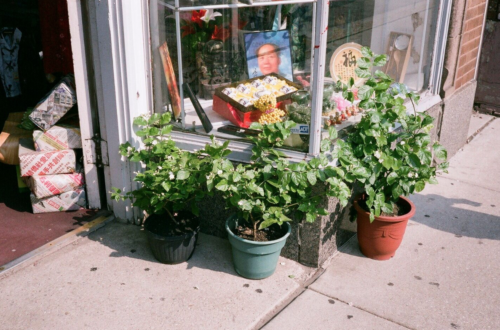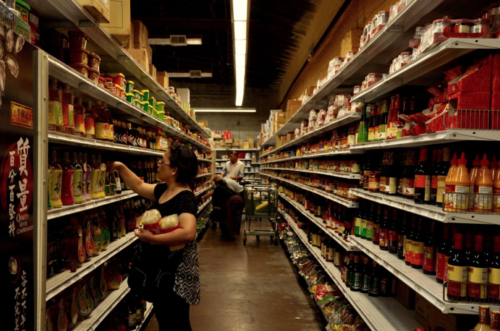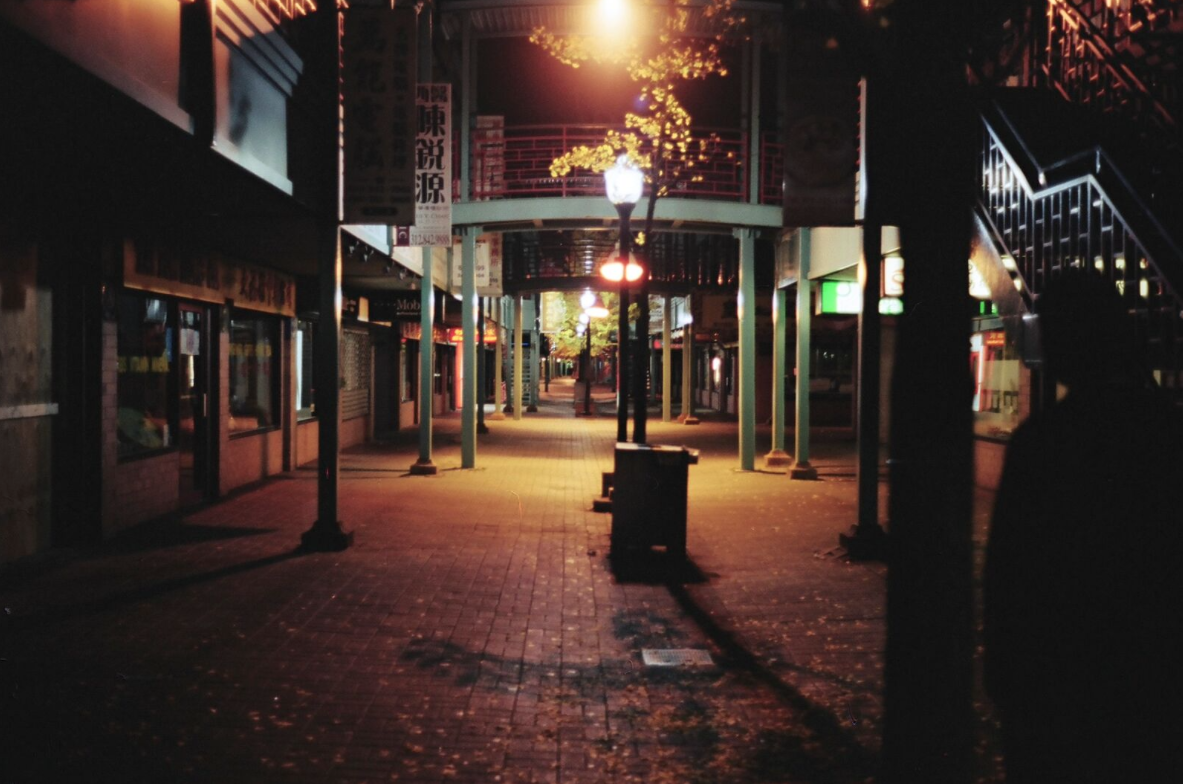- • Best Chinese Grocery Store
- • Best Collection of Under-Chronicled Histories
- • Best(-Kept) Bubble Tea Secret
- • Best Tiny Park
- • Best Place to Get Your Trainspotting and Boat-Watching Fix Simultaneously
My father and my grandfather had a hand laundry on the North Side of Chicago in the Ravenswood Manor area. My grandfather used to take my sister and me down to Chinatown for shopping. It was a weekly activity. That’s what people who work in the laundry business do—they used their one day off to come to Chinatown to make connections with their relatives, friends, to socialize with each other, and to catch up on what’s happening back in their village in China.
My family’s story is one of the typical Chinese immigration stories.
Soo Lon Moy’s paternal grandfather moved to the United States years ago; he returned to China to get married, but he came back to America after the birth of his children. Moy’s father, born in China in 1923, later migrated to America when he was fifteen. Moy herself was born in Guangdong Province (formerly known as Canton). Soon after, her father moved the family to Hong Kong, as the then-British Crown colony guaranteed an ease of mobility that mainland China did not. In 1961, her entire family came to Chicago to join her father and grandfather.
Her first memories of Chinatown center around her weekly trips by bus to the neighborhood, and the close-knit community that she encountered there.

I remember going grocery shopping, and many of the grocers would dig into these big jars on their shelves to treat us to salted plums. And of course, they were always offering us tea. After shopping, we always stopped at bakeries and got coffee and pastries. My grandfather was very sociable and knew a lot of people down there, so it was like a big get-together when he brought us to Chinatown. It was a lot of fun.
After graduating from the University of Illinois at Chicago, Moy became a teacher at Chicago Public Schools: John C. Haines Elementary School in Chinatown and Robert Healy Elementary School in Bridgeport. During her thirty years of teaching, she witnessed demographic changes in these neighborhoods as the ethnic Chinese population expanded outwards.
Chinatown is cut off by highways, by the river, by the railroad, and all that. It was really confined, until we started expanding in the eighties to Chinatown Square. As more and more immigrants came, the ones who’ve been here longer started moving further south to Bridgeport, because they had more money and started looking for a better place to live. They started moving south and southwest. So the neighborhood started changing. People who’ve been here longer, they moved south, while most immigrants used Chinatown as a point of entry into Chicago.
After decades of continued engagement with the residents of Chinatown and Bridgeport, Moy was invited to volunteer at the Chinese-American Museum of Chicago.
Apart from the museum, Chicago has no other cultural center that tells our stories, our Chinese immigrant stories, so it’s very important. The Chinese have been in the States for so long, and came primarily because of the Gold Rush and the building of railroads, yet there was so much discrimination against the Chinese. They were driven out of towns on the West Coast. There were riots and murders. These stories cannot be found in history books. As I went through the Chicago Public Schools system, I never read anything about Chinese immigration and how the Chinese were treated, so I think it’s very important that we tell these stories and let people know that there were injustices, but that we also persevered and made better lives for our future generations.
We at the museum hope to be the repository of many of these Chinese American stories in the Midwest. That’s what we would like to accomplish. We feel that it’s important for our stories to be told. (Darren Wan)
For Soo Lon Moy, president of the board and chair of the exhibition committee of the Chinese-American Museum of Chicago, Chinatown is the locus of some of the most cherished memories of her formative years. Although she has never lived in the neighborhood, her personal and familial ties to Chinatown run deep.
Best Chinese Grocery Store
Hong Kong Market

Rows of unassuming apartment buildings and large warehouses are quietly tucked away in the southwest corner of Chinatown. Despite the massive sign beckoning to customers, the façade of Hong Kong Market—that of a wholesale warehouse, a function the building once served years ago—does not reveal too much about the space. Only when you enter the warehouse will you find yourself among busy carts carrying fresh fruit, boisterous exchanges in Cantonese, and the largest selection of Asian produce on the South Side.
Here, you can easily find ingredients used in Asian cuisines that are difficult to procure elsewhere in Chicago, such as baby kai lan (Chinese broccoli), packs of chicken feet, ginseng roots, fresh mangosteens, and frozen durians. Like most Cantonese supermarkets, Hong Kong Market has a live seafood selection, and a siu mei (roasted meats) deli section that serves barbecued pork (char siu) and roasted goose, all prepared daily.
If cooking does not interest you, Hong Kong Market also offers an amazing variety of snacks and frozen food, including a special aisle for Japanese food products. But Hong Kong Market is more than just a grocery store. You will come across all sorts of gadgets and appliances found in a traditional Chinese home: woks, rice cookers, wooden buckets, Taoist altar cabinets, and incense. Though it is a little out of the way, Hong Kong Market is a treasure trove for anyone seeking an authentic Cantonese shopping experience. (Jasmin Liang)
Hong Kong Market, 2425 S. Wallace St. Open daily, 8am–7pm. (312) 791-9111.
Best Collection of Under-Chronicled Histories
Chinese-American Museum of Chicago
The Chinese-American Museum of Chicago offers an intimate, thoughtfully curated experience, showcasing often-overlooked historical narratives of Chinese communities in the United States. Its rotating exhibits have spanned such diverse themes as “Chinese@Play”—which illustrated popular Chinese games and leisure activities—and the currently on-display “Rites of Passage,” an exploration of Chinese customs surrounding birth, marriage, longevity, and death. Despite their variety, the exhibits are consistently characterized by authentic artifacts and the commitment to providing a platform for people to tell their own stories. An ongoing exhibit, “My Chinatown: Stories from Within,” features an especially engaging use of multimedia—a sixteen-minute video, produced in collaboration with the Chicago History Museum, that captures Chinatown residents’ tales of the area. Watching this video in the setting of an exquisitely designed object theater is well worth the visit.
The museum’s mission is perhaps best exemplified by the permanent installation on its second floor. Titled “Great Wall to Great Lakes: Chinese Immigration to the Midwest,” it traces the journeys of immigrants who settled in Chicago and surrounding areas. In particular, the exhibit highlights the phenomenon of “paper sons,” a term for those who circumvented the Chinese Exclusion Act to gain admission to the United States by purchasing fraudulent documents that declared them to be blood relations of legal American citizens. Exhibits like this reflect the museum’s dedication to chronicling the unique experiences and cultural practices of Chinese-Americans.
This strong sense of purpose has sustained the museum since it first opened its doors in 2005; despite a two-year closure forced by a 2008 fire, it still continues its mission of preserving and celebrating lesser-known snapshots of the Chinese-American experience. (Lilian Huang)
Chinese-American Museum of Chicago, 238 W. 23rd St. Tuesday–Friday, 9:30am–1:30pm; Saturday–Sunday, 10am–5pm. Free with suggested donation of $5 for adults, $3 for students and seniors. (312) 949-1000. ccamuseum.org
Best(-Kept) Bubble Tea Secret
Hello Jasmine
Hidden within Little Lamb Hot Pot restaurant, Hello Jasmine does not have its own storefront. Only a sign on the hot pot restaurant’s wall (“Bubble tea is here”) announces its presence. In fact, the owner of Hello Jasmine, I Min Lin, is also the customer manager at Little Lamb Hot Pot. He founded the bubble tea shop half a year ago along with his wife Jasmine Chang.
The menu is simple but provides all essential options. Customers can choose one of four kinds of tea leaves, and adjust the ice and sweetness level based on personal preferences. It is the only place in Chicago that serves Taiwan Pouchong milk tea, a classic Taiwanese beverage. It is smooth and lightly sweetened, with a kick of oolong fragrance lingering on the tongue.
“All of our ingredients are handpicked by my wife and directly imported from Taiwan: the tea leaves, tapioca, even the syrup,” says Lin, who grew up in Taiwan and worked in a handmade drinks shop there. For him, one should judge a cup of milk tea by the natural aroma of the tea leaves, not by its sweetness—sugar, explains Lin, is often used to mask the bitterness of low-quality teas. “We initially doubted how well the American public would receive Taiwanese flavors. But whenever our customers return for a second drink, we are really glad that we stuck to them.” (Jasmin Liang)
Hello Jasmine, 2201 S. Wentworth Ave. Monday–Thursday, 11:30am–10pm; Friday–Sunday, 11:30am–11pm. (312) 225-0600.
Best Tiny Park
Sun Yat-Sen Playlot Park
Located right next to the Stevenson Expressway, the Sun Yat-Sen Playlot Park has, for the most part, been forgotten since the construction of the much larger Ping Tom Memorial Park. However, for decades this Park was the only green space in Chinatown after the razing of other parks for the construction of the Stevenson and Dan Ryan Expressways in the 1950s. Between the mid-1970s and the early 2000s, it served as the neighborhood’s sole refuge from the ceaseless flurry of urban activity.
Among the park’s amenities are a pavilion and a new playground that was completed in 2015 as part of the “Chicago Plays!” Playground Program. The park’s centerpiece is a bust of Sun Yat-Sen—an homage to, depending on who you ask, a Chinese anti-imperialist/nationalist/democratic/revolutionary/socialist hero. Groups of old Chinese men often gather at tables around the bust, playing or observing games of Chinese chess. If you’re lucky, you might catch residents practicing tai chi here, enjoying a brief reprieve from the hectic pace of urban living, albeit in close proximity to the perennial tumult of I-55. (Darren Wan)
Sun Yat-Sen Playlot Park, 251 W. 24th Pl. Open daily, 6am–11pm. (312) 747-0291.
Best Place to Get Your Trainsporting and Boat-Watching Fix Simultaneously
Pennsylvania Railroad Bridge No. 458 (Canal Street Railroad Bridge)
If you’ve ever gotten off at the Cermak-Chinatown Red Line stop, you may have spotted the two rusted towers of Pennsylvania Railroad Bridge No. 458 rising in the distance. Situated next to Ping Tom Memorial Park, the Railroad Bridge is the only vertical lift bridge to span the Chicago River, and was officially designated as a Chicago landmark in 2007. The century-old bridge still functions much the same way it did when it was built in 1914. When Amtrak trains aren’t using the bridge to speed across the river, boats can give one long and one short horn blast to signal to the bridge operator that they wish to cross. The operator, sitting in a little shack atop the bridge, will then sound the sirens and raise the horizontal length of railroad track.
The bridge operates surprisingly smoothly and quietly for a mechanism so old, emitting only soft clanks and squeaks until it finally settles back into place with a muffled boom. Some sunny afternoon, you can set yourself down on a boulder among the willow trees to hear the boatsmen sounding their horns, feel the trains rumbling past, and watch the bridge in action. (Anna Christensen)
Near 19th St., east of Lumber Street. Best viewed from Ping Tom Memorial Park, 1700 S. Wentworth Ave.


Great articles. I can’t wait to visit the Hong Kong Market. I never knew it was there!
Soo Lon Moy thank you for sharing your story. I didn’t know you were a teacher..awesome. Keep up the great work. Your smile always brightens the room.